Analysis of Transformational and Democratic Nursing Leadership Styles
VerifiedAdded on 2021/09/10
|9
|2181
|90
Essay
AI Summary
This essay delves into the characteristics of transformational and democratic nursing leadership within healthcare, analyzing their impact on workplace communication, culture, and patient safety. It defines workplace culture and a 'no blame' culture, highlighting how these leadership styles can facilitate or hinder enhanced communication and a positive work environment. The essay examines the principles of transformational leadership, emphasizing its role in inspiring and motivating nurses, fostering innovation, and promoting evidence-based practice. It also explores democratic leadership, which involves nurses in decision-making, leading to increased staff engagement. The analysis includes a discussion of the advantages and disadvantages of each style, supported by contemporary literature, ultimately concluding that effective leadership is crucial for strengthening the quality and integration of care in healthcare settings. The essay also references the importance of a 'just culture' in healthcare, which empowers nurses to learn from errors without fear of reprisal, and highlights the impact of leadership on patient safety outcomes.
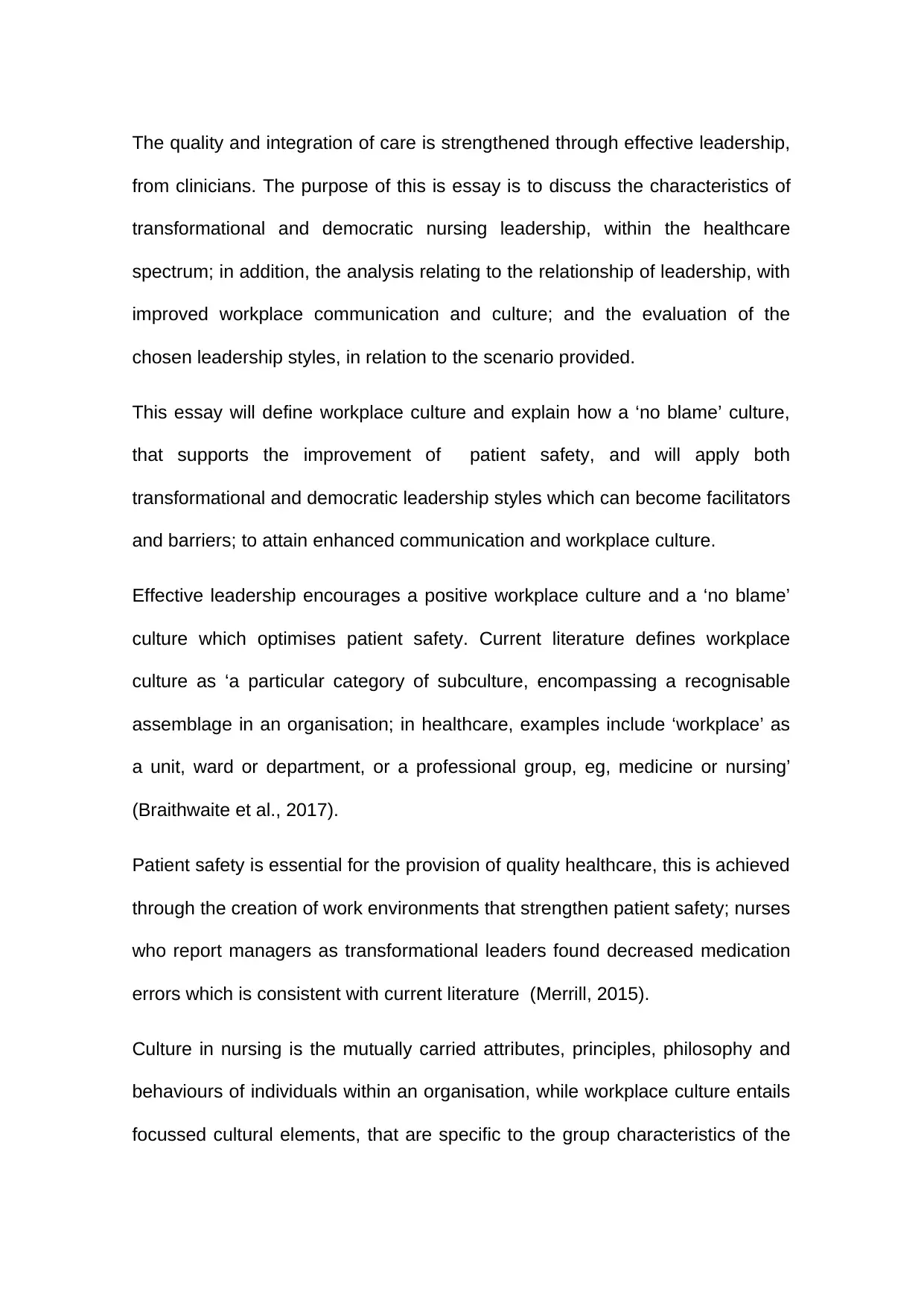
The quality and integration of care is strengthened through effective leadership,
from clinicians. The purpose of this is essay is to discuss the characteristics of
transformational and democratic nursing leadership, within the healthcare
spectrum; in addition, the analysis relating to the relationship of leadership, with
improved workplace communication and culture; and the evaluation of the
chosen leadership styles, in relation to the scenario provided.
This essay will define workplace culture and explain how a ‘no blame’ culture,
that supports the improvement of patient safety, and will apply both
transformational and democratic leadership styles which can become facilitators
and barriers; to attain enhanced communication and workplace culture.
Effective leadership encourages a positive workplace culture and a ‘no blame’
culture which optimises patient safety. Current literature defines workplace
culture as ‘a particular category of subculture, encompassing a recognisable
assemblage in an organisation; in healthcare, examples include ‘workplace’ as
a unit, ward or department, or a professional group, eg, medicine or nursing’
(Braithwaite et al., 2017).
Patient safety is essential for the provision of quality healthcare, this is achieved
through the creation of work environments that strengthen patient safety; nurses
who report managers as transformational leaders found decreased medication
errors which is consistent with current literature (Merrill, 2015).
Culture in nursing is the mutually carried attributes, principles, philosophy and
behaviours of individuals within an organisation, while workplace culture entails
focussed cultural elements, that are specific to the group characteristics of the
from clinicians. The purpose of this is essay is to discuss the characteristics of
transformational and democratic nursing leadership, within the healthcare
spectrum; in addition, the analysis relating to the relationship of leadership, with
improved workplace communication and culture; and the evaluation of the
chosen leadership styles, in relation to the scenario provided.
This essay will define workplace culture and explain how a ‘no blame’ culture,
that supports the improvement of patient safety, and will apply both
transformational and democratic leadership styles which can become facilitators
and barriers; to attain enhanced communication and workplace culture.
Effective leadership encourages a positive workplace culture and a ‘no blame’
culture which optimises patient safety. Current literature defines workplace
culture as ‘a particular category of subculture, encompassing a recognisable
assemblage in an organisation; in healthcare, examples include ‘workplace’ as
a unit, ward or department, or a professional group, eg, medicine or nursing’
(Braithwaite et al., 2017).
Patient safety is essential for the provision of quality healthcare, this is achieved
through the creation of work environments that strengthen patient safety; nurses
who report managers as transformational leaders found decreased medication
errors which is consistent with current literature (Merrill, 2015).
Culture in nursing is the mutually carried attributes, principles, philosophy and
behaviours of individuals within an organisation, while workplace culture entails
focussed cultural elements, that are specific to the group characteristics of the
Paraphrase This Document
Need a fresh take? Get an instant paraphrase of this document with our AI Paraphraser
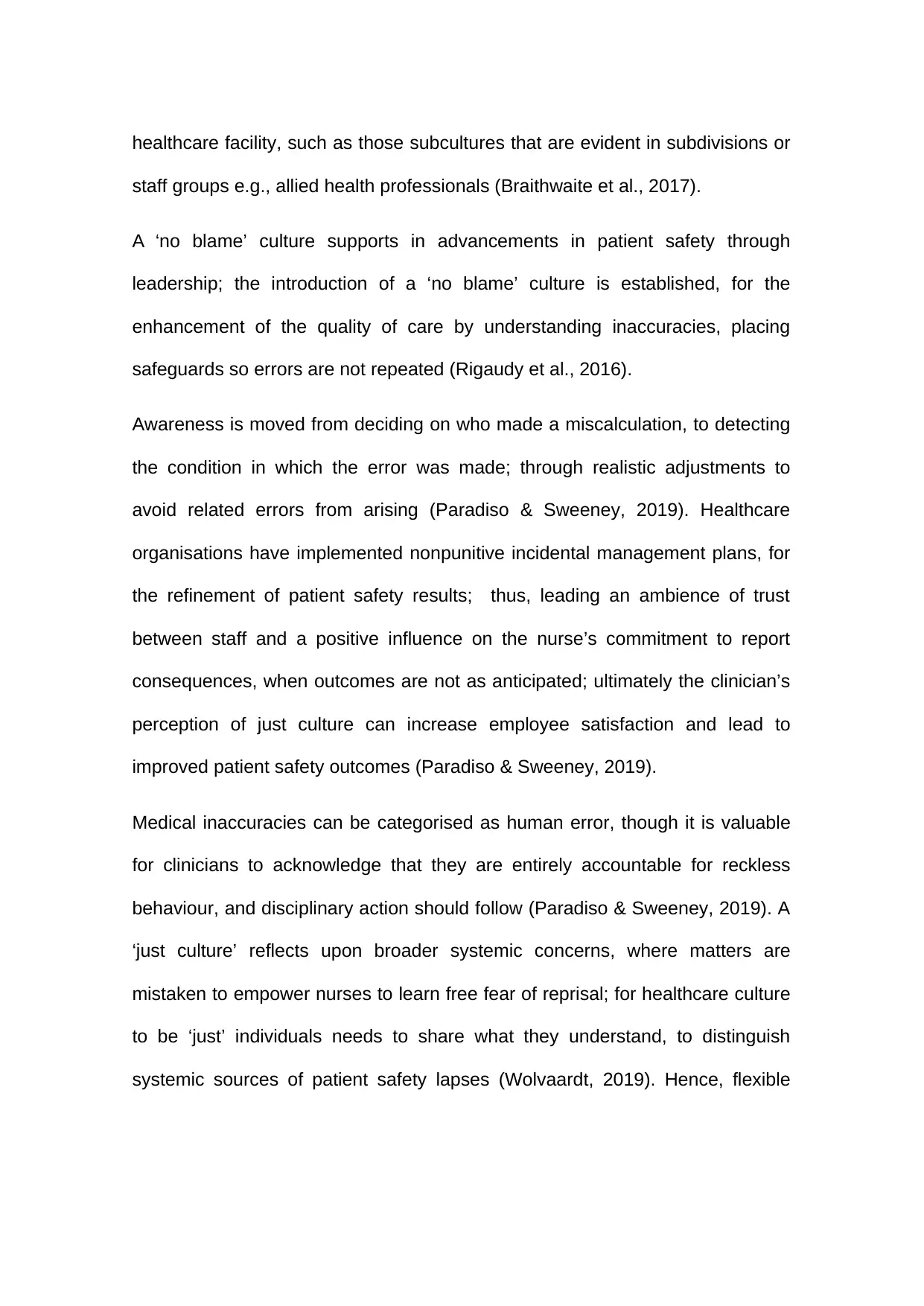
healthcare facility, such as those subcultures that are evident in subdivisions or
staff groups e.g., allied health professionals (Braithwaite et al., 2017).
A ‘no blame’ culture supports in advancements in patient safety through
leadership; the introduction of a ‘no blame’ culture is established, for the
enhancement of the quality of care by understanding inaccuracies, placing
safeguards so errors are not repeated (Rigaudy et al., 2016).
Awareness is moved from deciding on who made a miscalculation, to detecting
the condition in which the error was made; through realistic adjustments to
avoid related errors from arising (Paradiso & Sweeney, 2019). Healthcare
organisations have implemented nonpunitive incidental management plans, for
the refinement of patient safety results; thus, leading an ambience of trust
between staff and a positive influence on the nurse’s commitment to report
consequences, when outcomes are not as anticipated; ultimately the clinician’s
perception of just culture can increase employee satisfaction and lead to
improved patient safety outcomes (Paradiso & Sweeney, 2019).
Medical inaccuracies can be categorised as human error, though it is valuable
for clinicians to acknowledge that they are entirely accountable for reckless
behaviour, and disciplinary action should follow (Paradiso & Sweeney, 2019). A
‘just culture’ reflects upon broader systemic concerns, where matters are
mistaken to empower nurses to learn free fear of reprisal; for healthcare culture
to be ‘just’ individuals needs to share what they understand, to distinguish
systemic sources of patient safety lapses (Wolvaardt, 2019). Hence, flexible
staff groups e.g., allied health professionals (Braithwaite et al., 2017).
A ‘no blame’ culture supports in advancements in patient safety through
leadership; the introduction of a ‘no blame’ culture is established, for the
enhancement of the quality of care by understanding inaccuracies, placing
safeguards so errors are not repeated (Rigaudy et al., 2016).
Awareness is moved from deciding on who made a miscalculation, to detecting
the condition in which the error was made; through realistic adjustments to
avoid related errors from arising (Paradiso & Sweeney, 2019). Healthcare
organisations have implemented nonpunitive incidental management plans, for
the refinement of patient safety results; thus, leading an ambience of trust
between staff and a positive influence on the nurse’s commitment to report
consequences, when outcomes are not as anticipated; ultimately the clinician’s
perception of just culture can increase employee satisfaction and lead to
improved patient safety outcomes (Paradiso & Sweeney, 2019).
Medical inaccuracies can be categorised as human error, though it is valuable
for clinicians to acknowledge that they are entirely accountable for reckless
behaviour, and disciplinary action should follow (Paradiso & Sweeney, 2019). A
‘just culture’ reflects upon broader systemic concerns, where matters are
mistaken to empower nurses to learn free fear of reprisal; for healthcare culture
to be ‘just’ individuals needs to share what they understand, to distinguish
systemic sources of patient safety lapses (Wolvaardt, 2019). Hence, flexible

leadership types are essential for safety and quality in the healthcare
environment.
Transformational leadership is a practice where leaders raise the goals and
motives of others, to greater levels by appealing to ethics and standards; where
the nursing leader has a set of internal principles and concepts and is influential
at inspiring others, to withstand greater good rather than their individual
interests (Renjith et al., 2015).
The style of transformational leadership recognises change, generates ideas to
lead through encouragement, and implements adjustments with the
commitment and teamwork of members within the organisation; so
transformational leadership style is crucial for the execution of change (Renjith
et al., 2015).
According to (Renjith et al., 2015), a transformational leader must possess
intellectual stimulation, individualised consideration, inspirational motivation,
and idealised influence; inspirational motivation requires the leader to inspire
nurses to achieve goals and aims, whilst inspiring them to accomplish their own
aims; individual stimulation allows the leader to value the inventive notions of
the nurses, and staff are not critiqued publicly for errors made, this enables
analytical thinking, problem resolving, and also empowers nurses.
The transformational leader uses various forms of communication such as
electronic newsletters, drop in sessions, email updates and face to face team
discussions; to motivate staff to perform efficiently, e.g. the leader can be
determined to achieve enhanced communication and patient safety through
environment.
Transformational leadership is a practice where leaders raise the goals and
motives of others, to greater levels by appealing to ethics and standards; where
the nursing leader has a set of internal principles and concepts and is influential
at inspiring others, to withstand greater good rather than their individual
interests (Renjith et al., 2015).
The style of transformational leadership recognises change, generates ideas to
lead through encouragement, and implements adjustments with the
commitment and teamwork of members within the organisation; so
transformational leadership style is crucial for the execution of change (Renjith
et al., 2015).
According to (Renjith et al., 2015), a transformational leader must possess
intellectual stimulation, individualised consideration, inspirational motivation,
and idealised influence; inspirational motivation requires the leader to inspire
nurses to achieve goals and aims, whilst inspiring them to accomplish their own
aims; individual stimulation allows the leader to value the inventive notions of
the nurses, and staff are not critiqued publicly for errors made, this enables
analytical thinking, problem resolving, and also empowers nurses.
The transformational leader uses various forms of communication such as
electronic newsletters, drop in sessions, email updates and face to face team
discussions; to motivate staff to perform efficiently, e.g. the leader can be
determined to achieve enhanced communication and patient safety through
⊘ This is a preview!⊘
Do you want full access?
Subscribe today to unlock all pages.

Trusted by 1+ million students worldwide

further training; reinforcements and praise can be offered for the
accomplishment of work in challenging circumstances; furthermore
individualised consideration can include responding to request, listening, and
making adjustments to work practices (Collins et al., 2019).
In a clinical environment the leader rationally promotes nurses to scientifically
and logically to utilise evidence-based practice; individualised consideration
refers to qualities of compassion, where leaders are mentors and recognise
staff based on creativity and innovation (Renjith et al., 2015). The
transformational leader expresses communication and exceptional interpersonal
skills, supporting staff based on needs; idealised influence alludes to the leader
should practice what they preach, to influence the staff and works on ‘actions
speak louder than words’ principles (Renjith et al., 2015).
Democratic leadership involves nurses’ ideas in the decision-making process,
though the final decision is accomplished by the leader; due to the perception of
ownership of the facility, staff are ambitious and fulfilled in the work
environment; these leaders always demonstrate provision of feedback as they
value incessant improvements (Samarakoon, 2019). The democratic leader
centres on individual traits and capabilities of each nurse, the leader utilises
positional power, to achieve the advantageous outcomes and allows for the
provision of an energising environment for staff; thus, assisting nurses to form
their own goals (Dahlkemper, 2017). Such characteristics are pleasing to staff
as individuals are well represented in all activities of the association; allowing
accomplishment of work in challenging circumstances; furthermore
individualised consideration can include responding to request, listening, and
making adjustments to work practices (Collins et al., 2019).
In a clinical environment the leader rationally promotes nurses to scientifically
and logically to utilise evidence-based practice; individualised consideration
refers to qualities of compassion, where leaders are mentors and recognise
staff based on creativity and innovation (Renjith et al., 2015). The
transformational leader expresses communication and exceptional interpersonal
skills, supporting staff based on needs; idealised influence alludes to the leader
should practice what they preach, to influence the staff and works on ‘actions
speak louder than words’ principles (Renjith et al., 2015).
Democratic leadership involves nurses’ ideas in the decision-making process,
though the final decision is accomplished by the leader; due to the perception of
ownership of the facility, staff are ambitious and fulfilled in the work
environment; these leaders always demonstrate provision of feedback as they
value incessant improvements (Samarakoon, 2019). The democratic leader
centres on individual traits and capabilities of each nurse, the leader utilises
positional power, to achieve the advantageous outcomes and allows for the
provision of an energising environment for staff; thus, assisting nurses to form
their own goals (Dahlkemper, 2017). Such characteristics are pleasing to staff
as individuals are well represented in all activities of the association; allowing
Paraphrase This Document
Need a fresh take? Get an instant paraphrase of this document with our AI Paraphraser
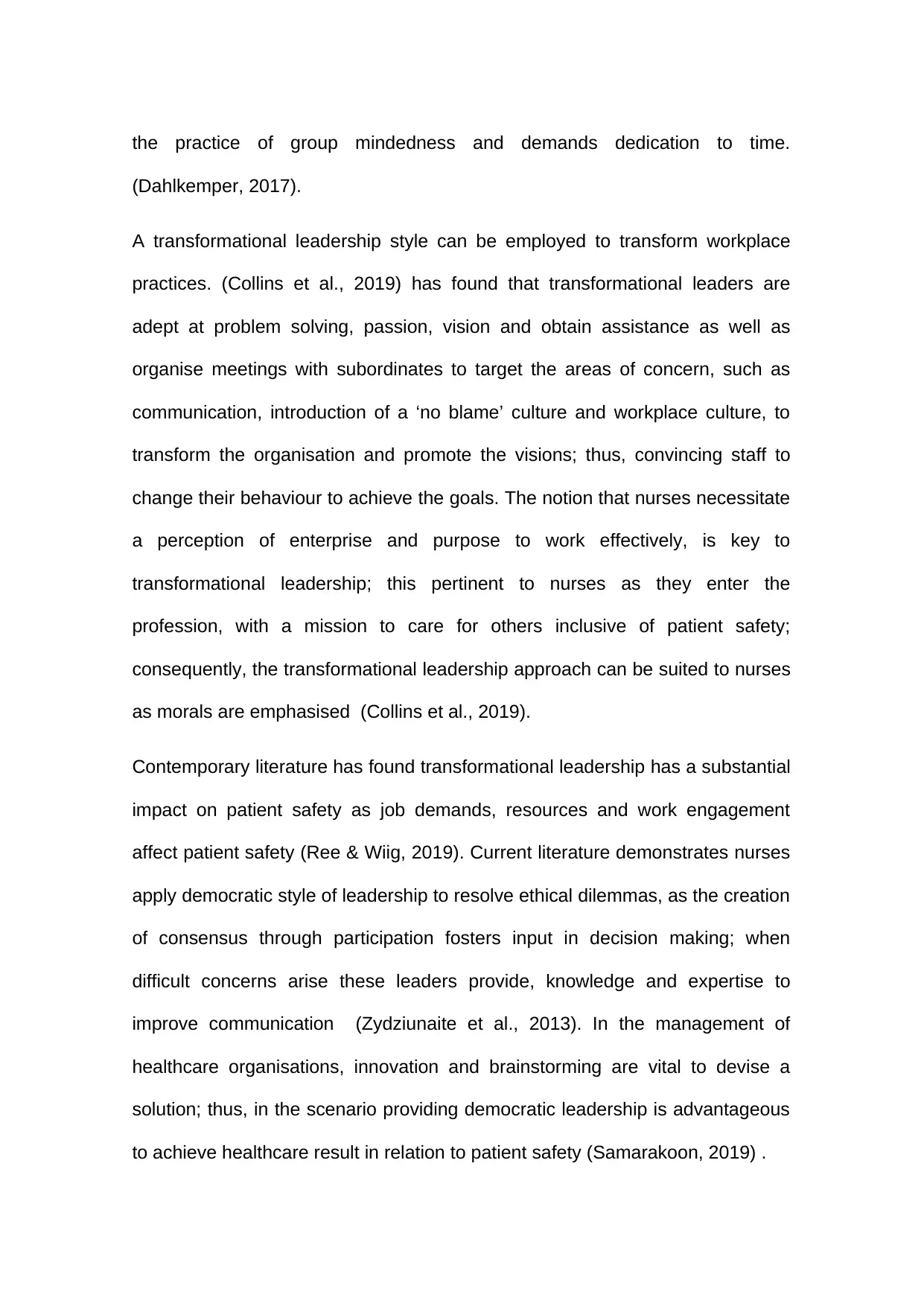
the practice of group mindedness and demands dedication to time.
(Dahlkemper, 2017).
A transformational leadership style can be employed to transform workplace
practices. (Collins et al., 2019) has found that transformational leaders are
adept at problem solving, passion, vision and obtain assistance as well as
organise meetings with subordinates to target the areas of concern, such as
communication, introduction of a ‘no blame’ culture and workplace culture, to
transform the organisation and promote the visions; thus, convincing staff to
change their behaviour to achieve the goals. The notion that nurses necessitate
a perception of enterprise and purpose to work effectively, is key to
transformational leadership; this pertinent to nurses as they enter the
profession, with a mission to care for others inclusive of patient safety;
consequently, the transformational leadership approach can be suited to nurses
as morals are emphasised (Collins et al., 2019).
Contemporary literature has found transformational leadership has a substantial
impact on patient safety as job demands, resources and work engagement
affect patient safety (Ree & Wiig, 2019). Current literature demonstrates nurses
apply democratic style of leadership to resolve ethical dilemmas, as the creation
of consensus through participation fosters input in decision making; when
difficult concerns arise these leaders provide, knowledge and expertise to
improve communication (Zydziunaite et al., 2013). In the management of
healthcare organisations, innovation and brainstorming are vital to devise a
solution; thus, in the scenario providing democratic leadership is advantageous
to achieve healthcare result in relation to patient safety (Samarakoon, 2019) .
(Dahlkemper, 2017).
A transformational leadership style can be employed to transform workplace
practices. (Collins et al., 2019) has found that transformational leaders are
adept at problem solving, passion, vision and obtain assistance as well as
organise meetings with subordinates to target the areas of concern, such as
communication, introduction of a ‘no blame’ culture and workplace culture, to
transform the organisation and promote the visions; thus, convincing staff to
change their behaviour to achieve the goals. The notion that nurses necessitate
a perception of enterprise and purpose to work effectively, is key to
transformational leadership; this pertinent to nurses as they enter the
profession, with a mission to care for others inclusive of patient safety;
consequently, the transformational leadership approach can be suited to nurses
as morals are emphasised (Collins et al., 2019).
Contemporary literature has found transformational leadership has a substantial
impact on patient safety as job demands, resources and work engagement
affect patient safety (Ree & Wiig, 2019). Current literature demonstrates nurses
apply democratic style of leadership to resolve ethical dilemmas, as the creation
of consensus through participation fosters input in decision making; when
difficult concerns arise these leaders provide, knowledge and expertise to
improve communication (Zydziunaite et al., 2013). In the management of
healthcare organisations, innovation and brainstorming are vital to devise a
solution; thus, in the scenario providing democratic leadership is advantageous
to achieve healthcare result in relation to patient safety (Samarakoon, 2019) .
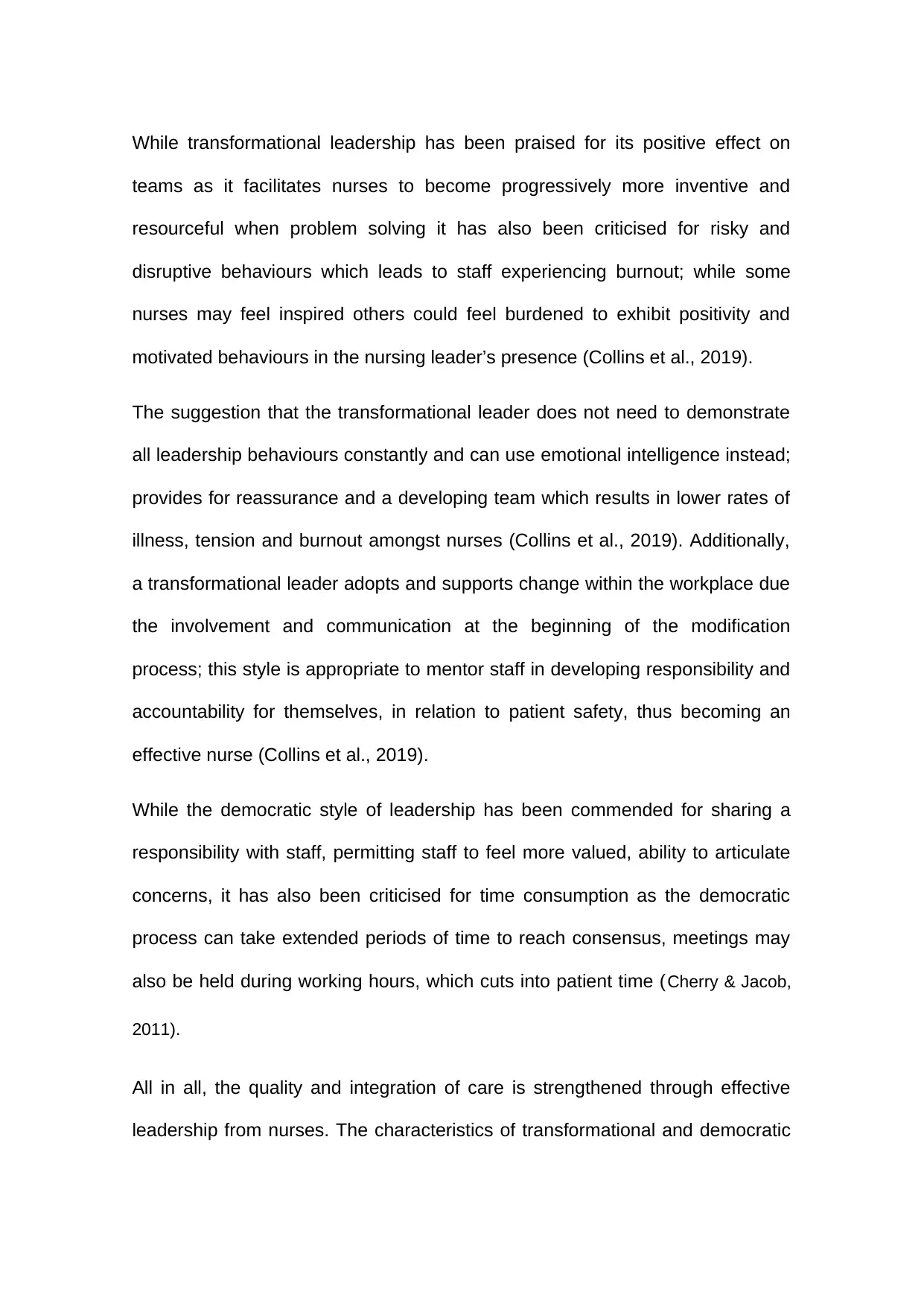
While transformational leadership has been praised for its positive effect on
teams as it facilitates nurses to become progressively more inventive and
resourceful when problem solving it has also been criticised for risky and
disruptive behaviours which leads to staff experiencing burnout; while some
nurses may feel inspired others could feel burdened to exhibit positivity and
motivated behaviours in the nursing leader’s presence (Collins et al., 2019).
The suggestion that the transformational leader does not need to demonstrate
all leadership behaviours constantly and can use emotional intelligence instead;
provides for reassurance and a developing team which results in lower rates of
illness, tension and burnout amongst nurses (Collins et al., 2019). Additionally,
a transformational leader adopts and supports change within the workplace due
the involvement and communication at the beginning of the modification
process; this style is appropriate to mentor staff in developing responsibility and
accountability for themselves, in relation to patient safety, thus becoming an
effective nurse (Collins et al., 2019).
While the democratic style of leadership has been commended for sharing a
responsibility with staff, permitting staff to feel more valued, ability to articulate
concerns, it has also been criticised for time consumption as the democratic
process can take extended periods of time to reach consensus, meetings may
also be held during working hours, which cuts into patient time (Cherry & Jacob,
2011).on this page you are
All in all, the quality and integration of care is strengthened through effective
leadership from nurses. The characteristics of transformational and democratic
teams as it facilitates nurses to become progressively more inventive and
resourceful when problem solving it has also been criticised for risky and
disruptive behaviours which leads to staff experiencing burnout; while some
nurses may feel inspired others could feel burdened to exhibit positivity and
motivated behaviours in the nursing leader’s presence (Collins et al., 2019).
The suggestion that the transformational leader does not need to demonstrate
all leadership behaviours constantly and can use emotional intelligence instead;
provides for reassurance and a developing team which results in lower rates of
illness, tension and burnout amongst nurses (Collins et al., 2019). Additionally,
a transformational leader adopts and supports change within the workplace due
the involvement and communication at the beginning of the modification
process; this style is appropriate to mentor staff in developing responsibility and
accountability for themselves, in relation to patient safety, thus becoming an
effective nurse (Collins et al., 2019).
While the democratic style of leadership has been commended for sharing a
responsibility with staff, permitting staff to feel more valued, ability to articulate
concerns, it has also been criticised for time consumption as the democratic
process can take extended periods of time to reach consensus, meetings may
also be held during working hours, which cuts into patient time (Cherry & Jacob,
2011).on this page you are
All in all, the quality and integration of care is strengthened through effective
leadership from nurses. The characteristics of transformational and democratic
⊘ This is a preview!⊘
Do you want full access?
Subscribe today to unlock all pages.

Trusted by 1+ million students worldwide

nursing leadership, within the healthcare setting; in addition to the relationship
of leadership, with improved workplace communication and culture; and the
evaluation of the chosen leadership styles, in relation to the scenario provided is
depicted and supported with contemporary literature.
Workplace culture and a ‘no blame’ culture, supports the improvement of
patient safety, and with the application of both transformational and democratic
leadership styles which can become facilitators and barriers; to attain enhanced
communication and workplace culture.
of leadership, with improved workplace communication and culture; and the
evaluation of the chosen leadership styles, in relation to the scenario provided is
depicted and supported with contemporary literature.
Workplace culture and a ‘no blame’ culture, supports the improvement of
patient safety, and with the application of both transformational and democratic
leadership styles which can become facilitators and barriers; to attain enhanced
communication and workplace culture.
Paraphrase This Document
Need a fresh take? Get an instant paraphrase of this document with our AI Paraphraser
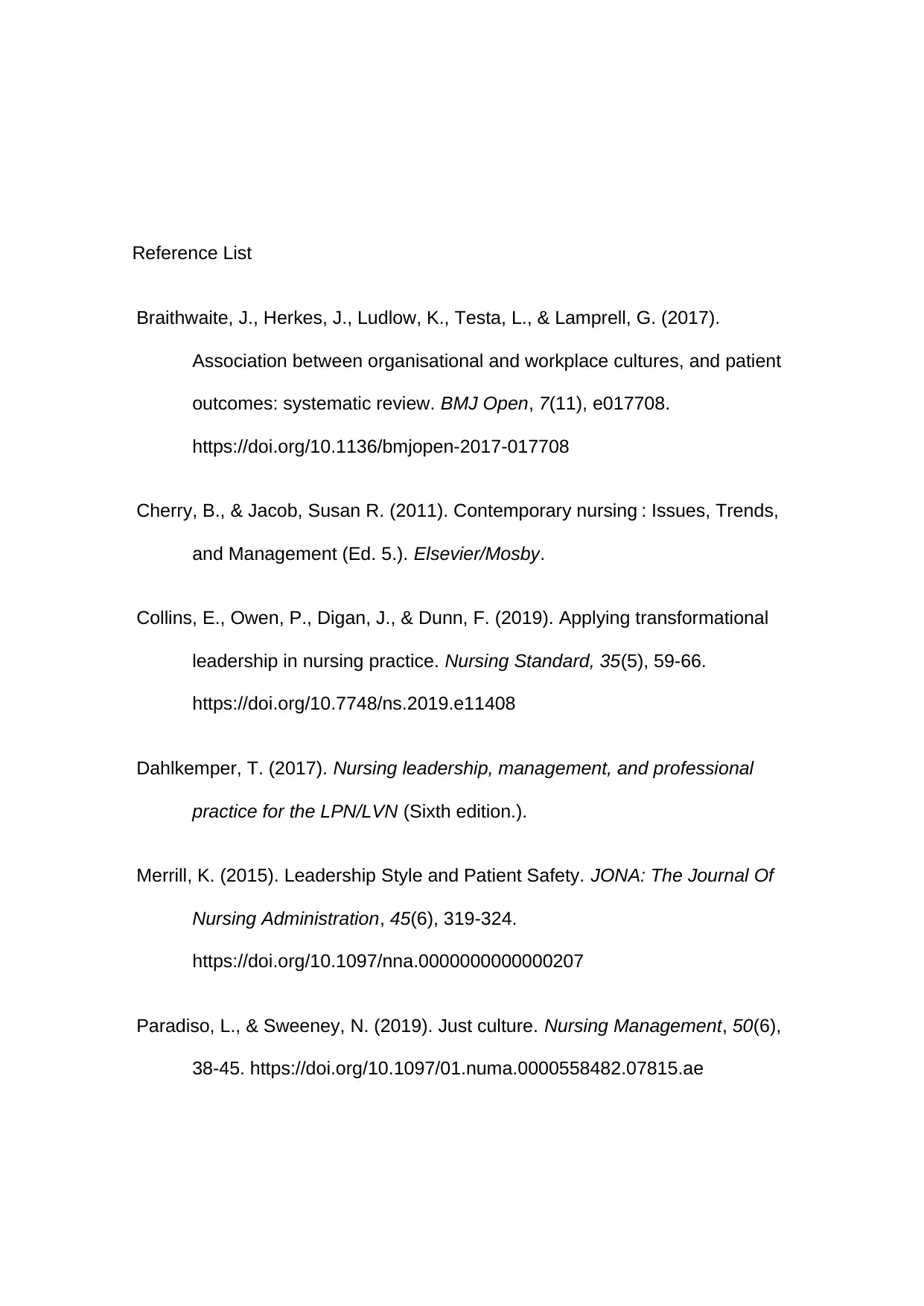
Reference List
Braithwaite, J., Herkes, J., Ludlow, K., Testa, L., & Lamprell, G. (2017).
Association between organisational and workplace cultures, and patient
outcomes: systematic review. BMJ Open, 7(11), e017708.
https://doi.org/10.1136/bmjopen-2017-017708
Cherry, B., & Jacob, Susan R. (2011). Contemporary nursing : Issues, Trends,
and Management (Ed. 5.). Elsevier/Mosby.
Collins, E., Owen, P., Digan, J., & Dunn, F. (2019). Applying transformational
leadership in nursing practice. Nursing Standard, 35(5), 59-66.
https://doi.org/10.7748/ns.2019.e11408
Dahlkemper, T. (2017). Nursing leadership, management, and professional
practice for the LPN/LVN (Sixth edition.).
Merrill, K. (2015). Leadership Style and Patient Safety. JONA: The Journal Of
Nursing Administration, 45(6), 319-324.
https://doi.org/10.1097/nna.0000000000000207
Paradiso, L., & Sweeney, N. (2019). Just culture. Nursing Management, 50(6),
38-45. https://doi.org/10.1097/01.numa.0000558482.07815.ae
Braithwaite, J., Herkes, J., Ludlow, K., Testa, L., & Lamprell, G. (2017).
Association between organisational and workplace cultures, and patient
outcomes: systematic review. BMJ Open, 7(11), e017708.
https://doi.org/10.1136/bmjopen-2017-017708
Cherry, B., & Jacob, Susan R. (2011). Contemporary nursing : Issues, Trends,
and Management (Ed. 5.). Elsevier/Mosby.
Collins, E., Owen, P., Digan, J., & Dunn, F. (2019). Applying transformational
leadership in nursing practice. Nursing Standard, 35(5), 59-66.
https://doi.org/10.7748/ns.2019.e11408
Dahlkemper, T. (2017). Nursing leadership, management, and professional
practice for the LPN/LVN (Sixth edition.).
Merrill, K. (2015). Leadership Style and Patient Safety. JONA: The Journal Of
Nursing Administration, 45(6), 319-324.
https://doi.org/10.1097/nna.0000000000000207
Paradiso, L., & Sweeney, N. (2019). Just culture. Nursing Management, 50(6),
38-45. https://doi.org/10.1097/01.numa.0000558482.07815.ae
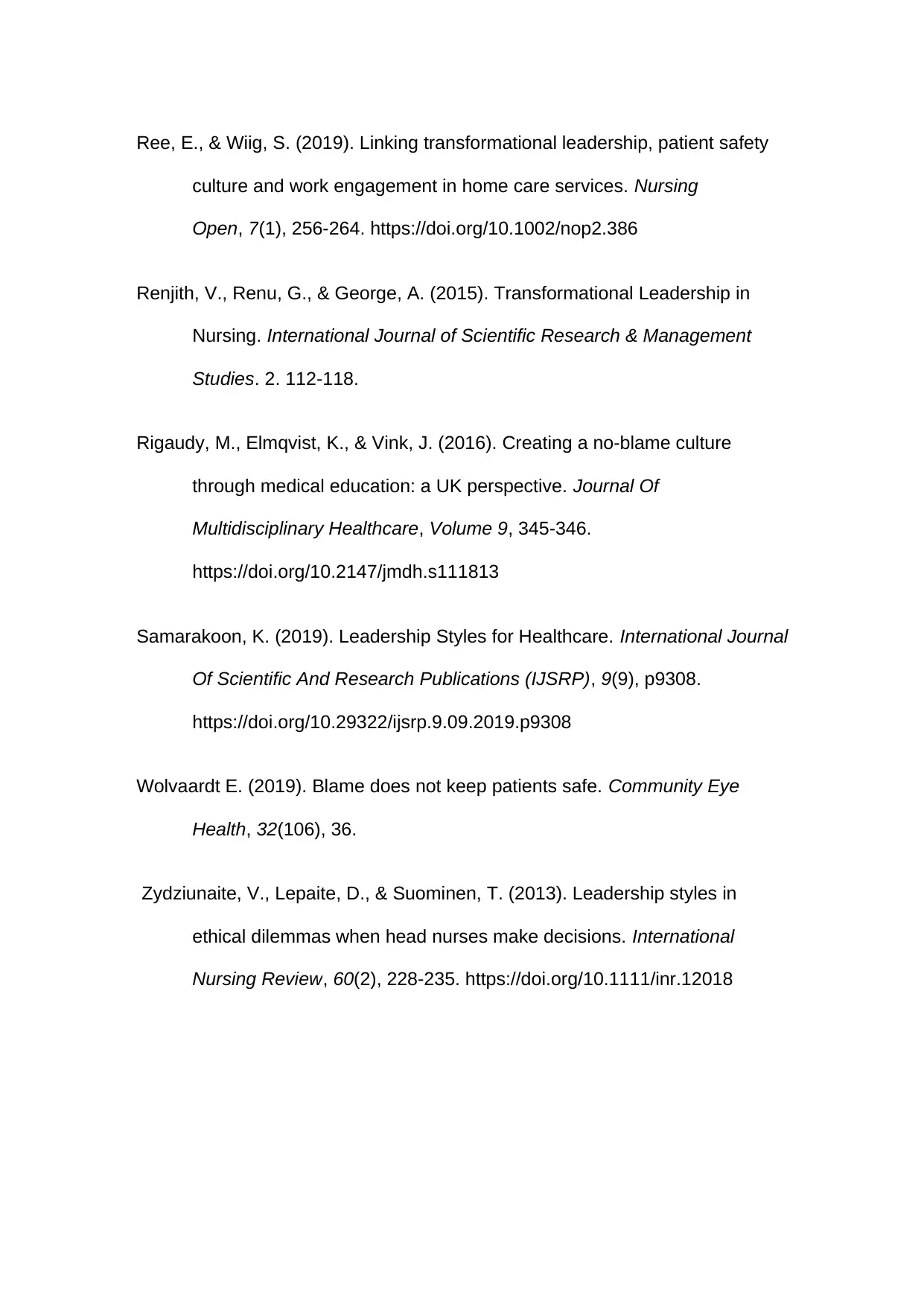
Ree, E., & Wiig, S. (2019). Linking transformational leadership, patient safety
culture and work engagement in home care services. Nursing
Open, 7(1), 256-264. https://doi.org/10.1002/nop2.386
Renjith, V., Renu, G., & George, A. (2015). Transformational Leadership in
Nursing. International Journal of Scientific Research & Management
Studies. 2. 112-118.
Rigaudy, M., Elmqvist, K., & Vink, J. (2016). Creating a no-blame culture
through medical education: a UK perspective. Journal Of
Multidisciplinary Healthcare, Volume 9, 345-346.
https://doi.org/10.2147/jmdh.s111813
Samarakoon, K. (2019). Leadership Styles for Healthcare. International Journal
Of Scientific And Research Publications (IJSRP), 9(9), p9308.
https://doi.org/10.29322/ijsrp.9.09.2019.p9308
Wolvaardt E. (2019). Blame does not keep patients safe. Community Eye
Health, 32(106), 36.
Zydziunaite, V., Lepaite, D., & Suominen, T. (2013). Leadership styles in
ethical dilemmas when head nurses make decisions. International
Nursing Review, 60(2), 228-235. https://doi.org/10.1111/inr.12018
culture and work engagement in home care services. Nursing
Open, 7(1), 256-264. https://doi.org/10.1002/nop2.386
Renjith, V., Renu, G., & George, A. (2015). Transformational Leadership in
Nursing. International Journal of Scientific Research & Management
Studies. 2. 112-118.
Rigaudy, M., Elmqvist, K., & Vink, J. (2016). Creating a no-blame culture
through medical education: a UK perspective. Journal Of
Multidisciplinary Healthcare, Volume 9, 345-346.
https://doi.org/10.2147/jmdh.s111813
Samarakoon, K. (2019). Leadership Styles for Healthcare. International Journal
Of Scientific And Research Publications (IJSRP), 9(9), p9308.
https://doi.org/10.29322/ijsrp.9.09.2019.p9308
Wolvaardt E. (2019). Blame does not keep patients safe. Community Eye
Health, 32(106), 36.
Zydziunaite, V., Lepaite, D., & Suominen, T. (2013). Leadership styles in
ethical dilemmas when head nurses make decisions. International
Nursing Review, 60(2), 228-235. https://doi.org/10.1111/inr.12018
⊘ This is a preview!⊘
Do you want full access?
Subscribe today to unlock all pages.

Trusted by 1+ million students worldwide
1 out of 9
Related Documents
Your All-in-One AI-Powered Toolkit for Academic Success.
+13062052269
info@desklib.com
Available 24*7 on WhatsApp / Email
![[object Object]](/_next/static/media/star-bottom.7253800d.svg)
Unlock your academic potential
Copyright © 2020–2025 A2Z Services. All Rights Reserved. Developed and managed by ZUCOL.




